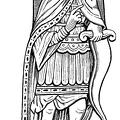18/19
Home / Albums / The Middle Ages / Rulers and Government /
King Charlemagne receiving the Oath of Fidelity
King Charlemagne receiving the Oath of Fidelity and Homage from one of his great Feudatories or High Barons
Originally, the possession of a benefice or fief meant no more than the privilege of enjoying the profits derived from the land, a concession which made the holder dependent upon the proprietor. He was in fact his "man," to whom he owed homage, service in case of war, and assistance in any suit the proprietor might have before the King's tribunal.
- Author
- The Project Gutenberg EBook of Manners, Custom and Dress During the Middle Ages and During the Renaissance Period, by Paul Lacroix
- Posted on
- Tuesday 3 March 2020
- Dimensions
- 1227*975
- Tags
- Charlemagne, Royalty
- Albums
- Visits
- 1561
- Downloads
- 62
 Download Photo
Download Photo





